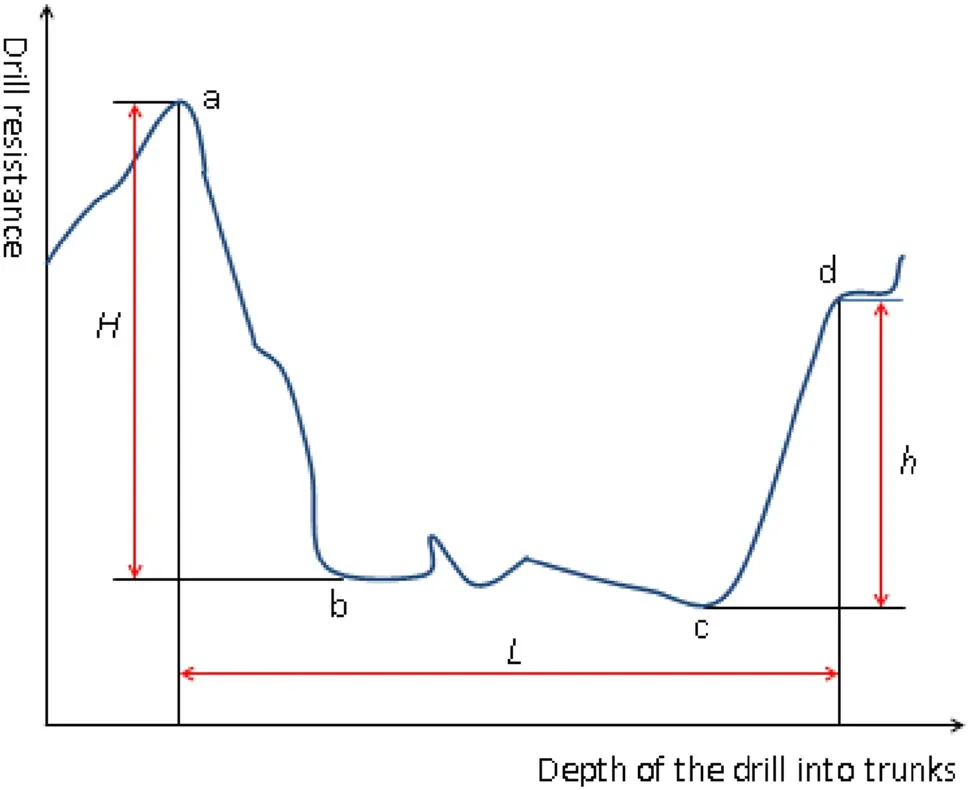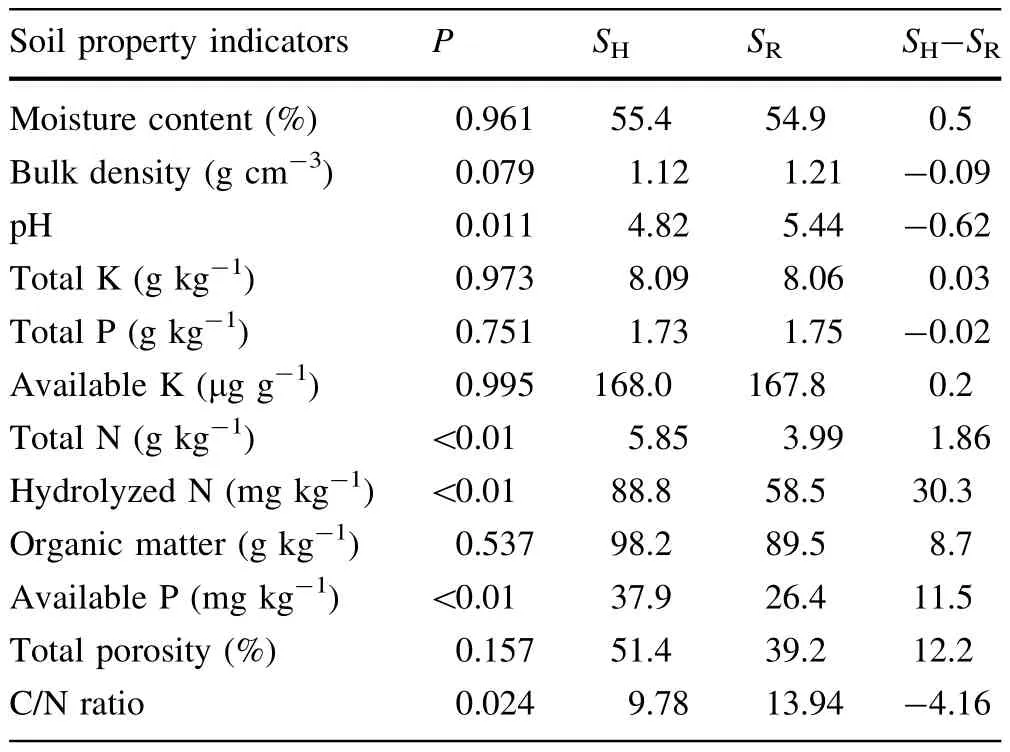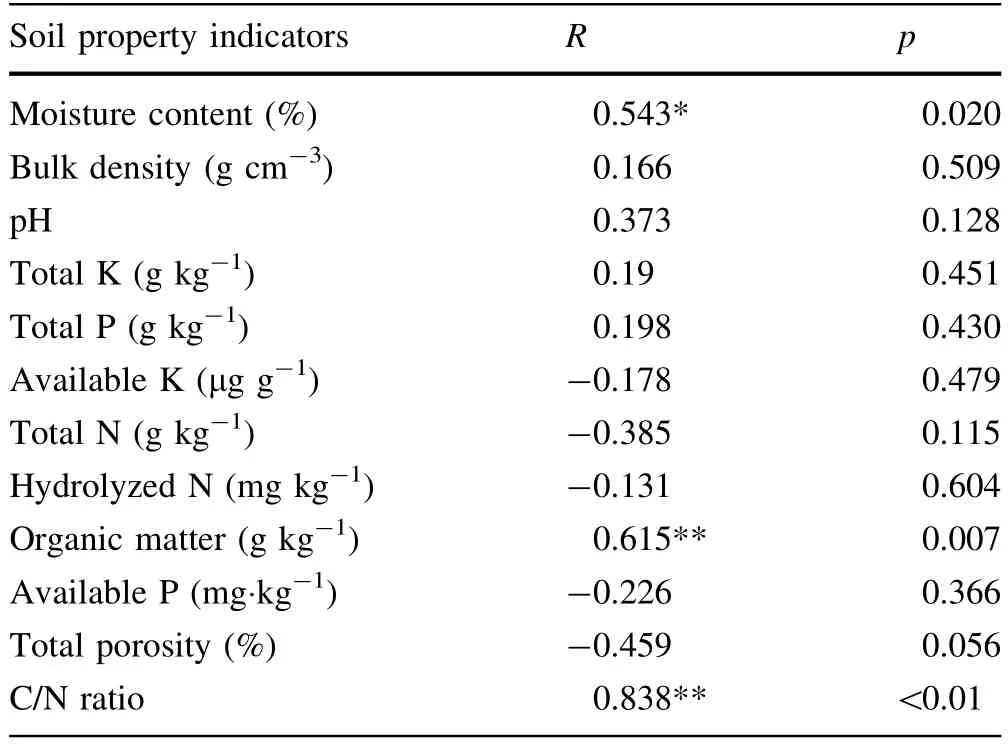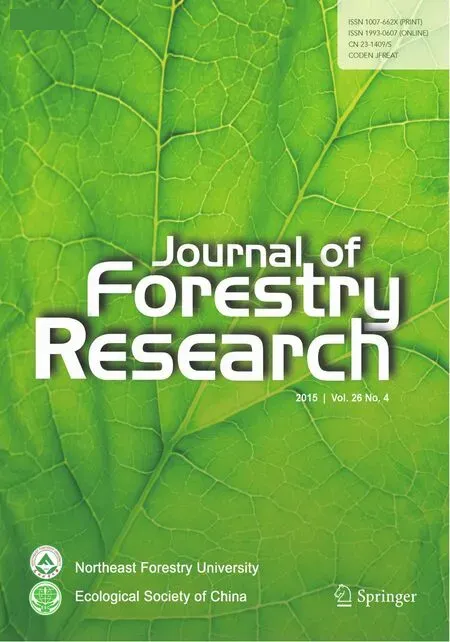Effect of soil physical–chemical properties on the decay of standing Pinus koraiensis in Xiaoxing’an Mountains, northeast China
•••
ORIGINAL PAPER
Effect of soil physical–chemical properties on the decay of standing Pinus koraiensis in Xiaoxing’an Mountains, northeast China
Tianyong Sun1•Lihai Wang2•Huadong Xu1•Zhenyu Bao1
©Northeast Forestry University and Springer-Verlag Berlin Heidelberg 2015
We selected 18 rotten and nine healthy postmature live standing Korean pine(Pinus koraiensis)to study the correlation between the degree of tree decay and soil physical–chemical properties in the Dialing Forest District of the Xiaoxing’an Mountains,China.One transverse section of each sample tree at 40–50 cm height above the ground was tested by Resistograph to determine the inner decay status.We collected soil samples around the root zones(6–20 cm depth)of each sample tree to test the soil physical–chemical indicators including moisture content,bulk density,total porosity,pH,organic matter content,total and hydrolyzed N contents,total and available P contents,total and available K contents,and C/N ratio.The degree of decay of postmature Korean pine live standing trees was signif i cantly and positively correlated with the C/N ratio(R=0.838,P<0.05),organic matter (R=0.615,P=0.007)and moisture content(R=0.543,P=0.020)of soil around the root.The contents of total N, hydrolyzed N and available P in the soil under healthy sample trees were signif i cantly greater than those under decayed sample trees,and larger N and P contents might inhibit the decay fungi breeding in soils of pH 4.4–6.29. The optimum multiple regression equation for degree of tree decay on soil physical–chemical indicators showed that the linear correlations between the degree of decay and soil C/N ratio and pH were signif i cant(P<0.01)and the correlation was high(R2=0.778).Enhancement soil C/N ratio and pH could promote the decay of tree trunks.
Pinus koraiensis⋅Soil physical–chemical properties⋅Resistograph⋅Trunk decay⋅Xiaoxing’an Mountains
Introduction
Decay of live standing trees,which decreases wood value and even kills trees,is responsible for vast losses of timber resources.It is especially important to take appropriate measures to reduce decay because of the limited forest resource in China.Wood decay is caused by decay fungi eroding wood cell walls.Four conditions are necessary for fungi growth,viz.appropriate moisture,temperature, amount of oxygen,and suff i cient nutrients(Forest Products Laboratory 1967;Carll and Highley 1999).Additionally, soil pH greatly affects the growth of fungi(van der Wal et al.2007;Zhang 2003).The seriousness of Korean pine root rot differs by slope aspect and position on the slope, which ref l ect differences in temperature and moisture of the substrate(Ju et al.1979).A study on the decay of aspen stakes in various climates showed that atmospheric humidity and soil moisture were important factors in wood decay(Gonza´lez et al.2008).The moisture of wood and temperature of air or wood are closely related to wood decay(Brischke and Rapp 2008;Matheron and Porchas2006).The role of oxygen in increasing wood decay is more important than moisture content(Kazemi et al.2001). Some reports suggested that addition of N to the environment can promote rotting of wood or litter by fungi(van der Wal et al.2007;Agren et al.2001).However,adding N has a negative or neutral effect on wood decay(Fog 1988). P is related to growth of fungi,and when P content in soil exceeds a threshold value,the growth of Arbuscular mycorrhizal fungi is inhibited(Zhang 2003).
Site conditions of live standing trees can have important effects on tree decay,but it remains unclear that how environmental factors affect the decay in trees(Ju et al. 1979;Brischke and Rapp 2008;Matheron and Porchas 2006;van der Wal et al.2007).Decay of trees is often localized in forests.If site conditions are changed properly, the decay of live standing trees can be reduced.For this purpose we need to know the key environmental factors affecting decay and the relationships between them.
Among various site conditions affecting decay,soil condition is one of the most important factors,because the water and nutrients are mainly dependent on the root absorption from soil.The properties of soil will affect the internal structure of trees and this directly inf l uences susceptibility to decay by fungi.
Materials and methods
Study site
Dailing Forestry District is located in northeastern Heilongjiang Province on the southern slope of the Xiaoxing’an Mountains,China(46°50′8′–46°59′20′N, 128°57′6′–129°17′50′E).The district is characterized by low and gentle topography ranging from 250 to 1050 m in elevation.The study site is in the cold temperate zone and continental monsoon climate,with average annual air temperature of 1.4°C,minimum air temperature of -40°C(f i rst 10 days of January),maximum air temperature of 37°C(July)and annual accumulated air temperature of 2156°C above 10°C,and 115 days without frost. Mean annual precipitation is 661 mm.
The soil in Dailing Forestry District is typicMolli-Boric Argosol(Cooperative Research Group on Chinese Soil Taxonomy 2001).The texture of the soil is loam and the bedrock of the soil includes granite,granite porphyry and gneiss.Hydromica is the main clay mineral of the soil, which is accompanied by vermiculite and kaolinite.The soil prof i le is O horizon of 2–6 cm,Ah horizon of 6–20 cm,B horizon of 20–73 cm,and C horizon of 73–106 cm.The district supports coniferous-broadleaved mixed forest of the temperate zone characterized by Korean pine(Pinus koraiensis)accompanied byUlmus pumila,Betula,Quercus mongolica,Populus ussuriensisand other broadleaved temperate tree species.The dominant tree species,besidesP.koraiensis,includeAbies fabri,Betula costata,Tilia tuan,Betula platyphylla,Fraxinus mandshurica,andAcer tegmentosum.
Sample trees and soil samples
We carried out f i eld tests and survey of Korean pines in a sample 30-ha plot in the 18th block of Dailing Forest District.First,we judged whether Korean pine was decayed or not by visual inspection.If decay was probable,we used a Resistograph(model number 4453,Rinntech,Germany)to determine its internal condition.We selected 18 rotted and 9 healthy live standing Korean pine trees of 60–80 cm diameter at breast height(DBH)in different parts of the sample plot.The slope gradient,position and aspectofthe siteswere 6°–8°,middle part of slopes,and west,respectively.
For each sample tree,we collected for chemical analysis mixed wet soil samples of 200 g from 4 sampling sites from the root zones of the trees.Soil in its natural state was obtained for physical analysis with a soil wreath knife from each of 4 sampling sites(Yu and Wang 1988;Wuhan University 2007).Soil samples were collected from the Ah horizon at depths of 6–20 cm.
Experiment methods
We used a Resistograph to test one cross section of each sample tree at 40–50 cm above ground in two perpendicular radial directions and recorded two resistance curves. We tested soil moisture content,bulk density and total porosity with the cutting-ring method.Soil chemical indicators pH,organic matter,total and hydrolyzed N,total and available P,total and available K content,and C/N ratio were assessed according to forest industry standards(LY) (Yu and Wang 1988;Wuhan University 2007;Li et al. 2012;Xie et al.2008).
Degree of decay
The resistance curves showed that the tree trunk was decayed where the wave trough followed the radial direction(Fig.1).The dramatic decrease in drill resistance at the wave trough indicated reduced wood mechanical strength caused by decay by fungi.Degree of decayE0(the unit is resi)is def i ned as:

where,Lis the length(cm)of the wave trough projection on the abscissa and the length of decay along the testing path of the Resistograph;Handhare the lengths of the left(ab)and right(cd)side projection of the wave trough on the ordinates,respectively,and they represent the falling range in mechanical strength between rotted and healthy parts of the trunk;Dis the diameter(mm)of a sample cross section.

Fig.1 Sketch of a resistance curve by Resistograph
After calculating the degree of decayof each resistance curve,the twovalues for each sample tree were averaged.The average value offor each sample tree was denoted aswas de fi ned as the maximum among allvalues.of each sample tree was divided byand then multiplied by 100,to yield the relative degree of decay in the sample tree,denoted byE.All healthy sample trees had a decay degree of zero.
Statistical analysis
We used Pearson correlation analysis to assess the correlation between degree of decay and each of the soil property indicators,and one-way analysis of variance and a non-parametric test to analyze the differences between soil parameters at the root zones of rotted and healthy sample trees(Xu and Zhong 2003;Zhang and Chen 2006).
We used multiple linear regression coupled with stepwise regression to construct the optimum regression equation relating the degree of tree decay with soil property indicators,which were the dependent and independent variables,respectively.In building the equation,those independent variables showing weak correlations with the dependent variable were removed from the equation one by one until all the independent variables had a strong correlation with the dependent variable.We used the principal component regression to establish a standardized regression equation relating tree decay to soil properties.The equation included all the 12 soil parameters as independent variables.All statistical analyses were made using SPSS 19.0 and followed procedures described by Xu and Zhong (2003).
Results
Differences between soil property indicators under decayed and healthy sample trees of Pinus koraiensis
Differences in soil total and hydrolyzed N contents,and available P contents(Table 1)between soils around healthy and rotted trees were signif i cant atP<0.01(Table 2). Differences in soil pH and C/N ratios(Table 1)between the two groups of soils were signif i cant atP<0.05(Table 2). The otherseven indicatorswere similarforthe two groupsof soils.The degree of tree decay was signif i cantly correlated with soil property indicators around the trees.
The mean values of soil property indicators around healthy and decayed sample trees were calculated separately and then compared to assess differences between them(Table 2).The average values of soil total N, hydrolyzed N and available P contents were 1.86 g kg-1, 30.3 and 11.5 mg kg-1,respectively,all were greater for healthy trees than for rotted trees.The mean values of soil pH and C/N ratio near healthy trees were 0.62 and 4.16, respectively,lower than those near decayed trees.
Correlation between tree decay and soil property indicators
Degree of decay(Table 3)was most strongly correlated with soil C/N ratio(r=0.838,P<0.01,Table 4).Degree of decay was also signif i cantly correlated with soil organic matter content(r=0.615,P=0.007)and soil moisture content(r=0.543,P=0.020).Degree of decay was not correlated with the other soil property indicators.
Multiple linear regression analysis
The optimum linear regression equation relating the degree of decay and soil parameters was:

where,Eis the degree of decay(the same below),andandare soil C/N ratio and pH,respectively.The regression coef fi cients of C/N ratio(P<0.01)and pH (P=0.01)were both signi fi cant,indicating that both had signi fi cant and positive linear correlation with the degree of decay The degree of decay increased with increasing soil C/N ratio and pH.

Table 1 Soil property indicators at Pinus koraiensis sample tree locations
Principal component analysis
The standardized regression equation for the degree of decay and the 12 soil parameters was:

The regression coef fi cients in this equation were comparative because they were standardized.The fi rst four regression coef fi cients had greater absolute values(soil C/N ratio,pH,organic matter and moisture content in descending order),which indicated that these four soil parameters were closely related to the degree of decay in standing trees.These results were consistent with those of correlation analysis and multiple linear regression.
Discussion
Relationship between the decay of trees and soil physical properties
Soil moisture content,of the three analyzed soil physical indicators,is necessary for the survival and reproduction of decay fungi,and is therefore closely related with the decay of trees.The degree of tree decay increased with increasing soil moisture,consistent with the results of previous studies.In one study of root decay in live standing Korean pine trees Ju et al.(1979)reported that trees growing in low andwet areas were more likely to be seriously infected with root rot than trees growing in other areas.Thus high soil moisture encourages the decay of Korean pine roots and base trunks.Higher atmospheric humidity and soil moisture in boreal and temperate forests increase the seriousness of aspen wood decay as well,but in tropical forests,the relationship is reversed(Gonza´lez et al.2008). It is thus clear that high levels of moisture in wood,air or soil will accelerate wood or tree decay in temperate forests. Though soil bulk density and total porosity were not correlated with tree decay in this study,their inf l uences on decay might have been neutralized by other factors.

Table 2 Differences in soil property indicators between soils around decayed and healthy trees of Pinus koraiensis

Table 3 Degree of decay of live standing tree trunks of Pinus koraiensis

Table 4 Correlation between degree of decay and soil property indicators
Relationship between the decay of trees and soil chemical properties
Soil organic matter content,N content and C/N ratio
The degree of decay of standing trees increased signif icantly with increasing organic matter content of soils.This is supported by earlier studies in which wood samples injected with decay fungi were placed or buried in two different soils and decay proved more serious in cultivated land than in the wild(van der Wal et al.2007).The primary difference between the two soil types was greater organic matter in the agricultural soil,which indicates that abundant organic matter in soil promoted wood decay by fungi.
Total and hydrolyzed N contents of soil under decayed sample trees were signif i cantly lower than those under healthy trees:higher N content in soil did not promote,but rather inhibited the decay of trees.Previous research concerning the relationship between wood decay and nitrogen content in wood or the surrounding environment yielded inconsistent conclusions because the inf l uencing mechanisms of nitrogen on wood decay are complicated and need to be further investigated.Some research showed that addition of N to an environment will accelerate fungal decay of wood or other organic matter because the eff iciency of decomposition of decay fungi is improved and the chemical composition of decomposed material is changed(van der Wal et al.2007;Agren et al.2001;Thiet et al.2006).However,other research concluded that addition of N makes no difference in wood decay or possibly restrains it,because the increase in N changes the competitive relationships between decay fungi,impedes the creation of some catabolic enzymes,and promotes production of substances that are toxic to decay fungi (Zhang 2003;Agren et al.2001).
The C/N ratios of soils under decayed trees were signif i cantly higher than those under healthy trees and greater extent of decay was associated with higher soil C/N ratios.Soil C/N ratio is a sensitive index of soil quality that measures the equilibrium condition of C and N nutrients in soil(Zhang et al.2011).Because the C/N ratio affects nitrogen mineralization and carbon immobilization,it is closely related to soil nutrient conditions and thereby indirectly inf l uences trees decay.However,the health status of trees caen,in turn,affect the C/N ratio in soils.We found that when tree decay reached the middle and advanced stages,the normal growth of trees was hindered and more litter fell from decayed trees.As a result,soil organic matter content increased following the decomposition of litter,and this resulted in higher C/N ratios.
Soil pH
Within a soil pH range of 4.4–6.29,the degree of decay of standing trees increased with increasing soil pH.Some research indicated that pH was a signif i cant factor affecting the breeding of decay fungi and wood decay(van der Wal et al.2007;Zhang 2003),and that decay fungi were more abundant in acidic environments(Chongqing Fuwang Ecological and Plastic Wood 2013;Suiyuan Edible Fungi Disinfectant Factory,Zengdu District,Suizhou City 2013; Mulder et al.2005).Soil pH at our sampling sites was between 4.4 and 6.29,which is faintly acid and appropriate forthe growth ofdecay fungi.Itappeared thathighersoilpH within acidic range favored the decay ofstanding tree trunks.
Soil K and P contents
Our results indicated that the available P content in soil under decayed trees was signif i cantly lower than that under healthy trees.Total P and total and available K contents in soils were similar in soils under healthy and decayed trees. Elements K and P are also necessary for decay fungi to breed.However,there are few reports concerning the relationship between K content and the growth of decay fungi.Zhang(2003)studied the adaptability of Arbuscular mycorrhizal fungi and reported that the critical value of available P content in soil was 19.8 mg kg-1for two fungi strains and 28.5 mg kg-1for another strain.When soil available P content was lower than the critical value, increasing the P content promoted the growth of fungi. When the available P content exceeded the critical value, the result was the opposite.We infer that the available P content of soils beneath healthy trees exceeded an undefi ned critical value and inhibited the breeding of decay fungi.
Conclusion
Degree of decay of postmature Korean pine live standing trees was signif i cantly and positively correlated with the C/N ratio(R=0.838,P<0.05),organic matter (R=0.615,P<0.01)and moisture content(R=0.543,P<0.05)of soils in the root zones of trees.
Total N,hydrolyzed N and available P contents of soils in the root zones of healthy sample trees were signif i cantly greater than the contents at decayed sample trees.This indicates that an excess of N or P in a soil might inhibit the breeding of decay fungi inside trees and protect trees from further decay.
The optimum multiple regression equation relating degree of tree decay with soil property indicators showedthat the linear correlations between the degree of decay and soil C/N ratio and pH were highly signif i cant(P<0.01) and the correlation between these variables was strong (R2=0.778).Tree decay degree increased with increasing soil C/N ratio and pH.
AcknowledgmentsWe gratefully acknowledge and thank Ming Gao,Bo Mao and Lingzhi Xie for their kind help on the experiments of soil property analysis.This study was funded by the Introduction Program of New Tech from Overseas(20140478)and the Forestry Nonprof i t Special Research Project(201104007).
Agren GI,Bosatta E,Magill AH(2001)Combining theory and experiment to understand effects of inorganic nitrogen on litter decomposition.Oecologia 128:94–98
Brischke C,Rapp AO(2008)Inf l uence of wood moisture content and wood temperature on fungal decay in the f i eld:observations in different micro-climates.Wood Sci Technol 42:663–677
Carll CG,Highley TL(1999)Decay of wood and wood-based products above ground in buildings.J Test Eval 27:150–158
Chongqing Fu Wang Ecological Wood and Plastic Wood.2013.The physiology and zoology of wood decay fungi.http://www. cqfwstm.com/shownews.asp?id=247.Accessed 22 Apr 2013(in Chinese)
Cooperative Research Group on Chinese Soil Taxonomy(2001) Chinese soil taxonomy.Science Press,Beijing,pp 145–183
Fog K(1988)The effect of added nitrogen on the rate of decomposition of organic matter.Biol Rev 63:433–462
Forest Products Laboratory,Forest Service,USDA(1967)Factors inf l uencing decay of untreated wood.United States Forest Service,Madison,pp 1–3
Gonza´lez G,Gould WA,Hudak AT,Hollingsworth TN(2008)Decay of aspen(Populus tremuloidesMichx.)wood in moist and dry boreal,temperate,and tropical forest fragments.AMBIO 37(7):588–597
Ju GZ,Xiang CT,Ji LQ,Zhang BH,Li YL,Zheng CF,Zhang YJ (1979)A study on root rot[ArmillariellaMellea(VOHL.ET FR.) Karst]of Korean Pine.J Northeast For Inst 2:49–58(in Chinese)
Kazemi SM,Dickinson DJ,Murphy RJ(2001)Effects of initial moisture content on wood decay at different levels of gaseous oxygen concentrations.J Agric Sci Technol 3:293–304
Li Y,Song QL,Ji H,Dong XB(2012)Impact of different transformation measures on soil physical and chemical properties and heavy metal content in low-quality forest stands in great Xing’an mountains.J Northeast For Univ 40(4):11–13(in Chinese)
Matheron ME,Porchas M(2006)Factors affecting the development of wood rot on lemon trees infected withAntrodia sinuosa,Coniophora eremophila,and aNodulisporiumsp.Plant Dis 90:554–558
Mulder C,van Wijnen HJ,van Wezel AP(2005)Numerical abundance and biodiversity of below-ground taxocenes along a pH gradient across the Netherlands.J Biogeogr 32(10): 1775–1790
Suiyuan Edible Fungi Disinfectant Factory in Zengdu District, Suizhou City.2013.Conditions for edible fungi’s normal growth and development.Available at:http://syxdj88.cn/page/newslist. htm?site_id=off i cialsite&is_diy=false&detailKey=2ed7f240d6c b4c73b9aa80ae99c70fae.Accessed 22 Apr 2013(in Chinese)
Thiet RK,Frey SD,Six J(2006)Do growth yield eff i ciencies differ between soil microbial communities differing in fungal:bacterial ratios?Reality check and methodological issues.Soil Biol Biochem 38(4):837–844
van der Wal A,de Boer W,Smant W,van Veen JA(2007)Initial decay of woody fragments in soil is inf l uenced by size,vertical position,nitrogen availability and soil origin.Plant Soil 301:189–201
Wuhan University(2007)Analytical chemistry,5th edn.Higher Education Press,Beijing,pp 312–336(in Chinese)
Xie KY,Huang ZH,Zhou YP,Ao HB(2008)Correlation analysis of forest f i res and meteorological factors.Jiangxi For Sci Technol 5:53–55(in Chinese)
Xu WK,Zhong LN(2003)Probability theory and mathematical statistics.Northeast Forestry University Press,Harbin, pp 218–236(in Chinese)
Yu TR,Wang ZQ(1988)Soil chemical analysis.Science Press, Beijing,pp 62–89(in Chinese)
Zhang XH.2003.The adaptability ofArbuscular mycorrhizalfungi to different soil environ-mental factors.Agricultural University of Hebei,Hebei Province,P.R.China,pp.5–10(in Chinese)
Zhang WB,Chen HY(2006)Practical data statistic analysis and SPSS 12.0 application.Posts and Telecom Press,Beijing, pp 93–97(in Chinese)
Zhang CH,Wang ZM,Ju WM,Ren CY(2011)Spatial and temporal variability of Soil C/N ratio in songnen plain maize belt.Environ Sci 32(5):1407–1414(in Chinese)
8 February 2014/Accepted:1 July 2014/Published online:21 July 2015
Project fund:This work was f i nancially supported by the Introduction Program of New Tech from Overseas(20140478)and the Forestry
Nonprof i t Special Research Project(201104007).
The online version is available at http://www.springerlink.com
Corresponding editor:Yu Lei
✉Lihai Wang
wanglihai2012@126.com
1College of Engineering and Technology,Northeast Forestry University,Harbin 150040,China
2Forest Operations and Forest Environment Research Center, Northeast Forestry University,Harbin 150040,China
 Journal of Forestry Research2015年4期
Journal of Forestry Research2015年4期
- Journal of Forestry Research的其它文章
- Culm characteristics and volume-weight relationship of a forest bamboo(Melocanna baccifera(Roxb.)Kurz)from northeast India
- Effects of characteristic inhomogeneity of bamboo culm nodes on mechanical properties of bamboo f i ber reinforced composite
- Simulating the heartwood formation process of Erythrophleum fordii in South China
- Wood liquefaction with phenol by microwave heating and FTIR evaluation
- The inf l uences of biotic and abiotic factors on the occurrence and severity of poplar canker disease in Qingfeng County,China and the management implications
- Purif i cation and structural analysis of the toxin AP-I from the pathogen of Bambusa pervariabilis×Dendrocalamopsis grandis blight
